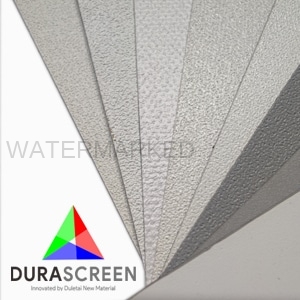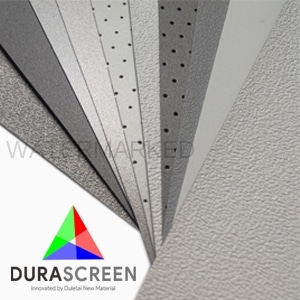Projection Screen
DuraScreen@Projection screen film and fabric series for different applications of projection screens like fixed frame, motorized, portable, inflatable…etc. We have hi-end materials for ALR/4K/3D home theatre and 5meter width seamless screen fabrics. Different projection screen fabric handle different applications and environments, their effectiveness depending on several factors, including the resolution of the media used, the lighting and acoustic conditions and the viewing angle of the audience. There are some key features for projection screen materials:
FLATNESS:
Flatness is the core value of the projection screen fabric. We import 5meter width stretchless calendering machine from Italy to imrpove the flatness of the pvc film. The film produced by this machine is from the real width without extending. So the material has top grade consistant thickness, low shrinkage and dimensional stablity. We also have advanced film to film, film to base fabric lamination machines opearted by skilled engineers to ensure the full product line has outstanding flatness.
GAIN:

Gain is a measurement describing the light reflectivity of a fabric, when the measurement is taken for light targeted and reflected perpendicular to the screen. A gain greater than 1.0 means the projection screen fabric increases the brightness of the projected image, while a gain less than 1.0 means the image produced is not as bright. This aspect is affected by the material colour, suface treatment and embossing pattern. We have different types of embossing rollers with delicate patterns to create accurate and uniformed glossy rate for different applicaitons of the projection screen fabric. When a measurement has a gain greater than 1.0, it reflects (front projection) or transmits (rear projection) more light than the white chalk tile. Gain is measured at different angles and is greatest at a 0° axis, when both the projected light and the viewer are parallel to the viewing surface. Gain decreases as the viewing angle becomes wider.
VIEWING ANGLE:
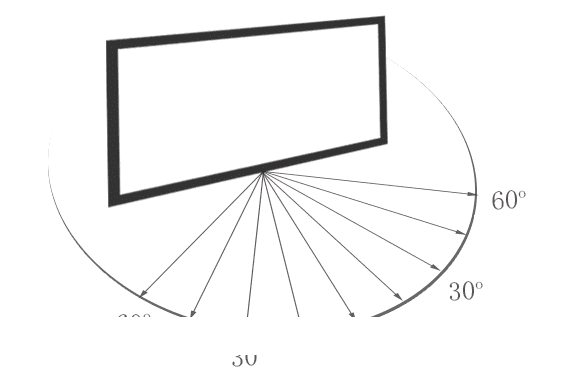
Viewing angle is a measurement describing the maximum angle from the center of the screen at which you can still see a quality image. Some projection screen fabric reflect most of the light perpendicularly to the screen, sending much less to the sides. This makes the screen appear much darker and more distorted if the viewers are not in the optimal viewing angle of the screen. Unfortunately, high-gain fabrics tend to have a lower viewing angle.
MATERIAL SURFACE:
The color of the projection screen fabric greatly influences the contrast of your final projected image. White screens are the industry standard due to brightness, while gray screens are better at handling darker tones. The picture format is the width-to-height ratio of a defined picture. Here are some of the common ratios for screens.
FRONT PROJECTION:
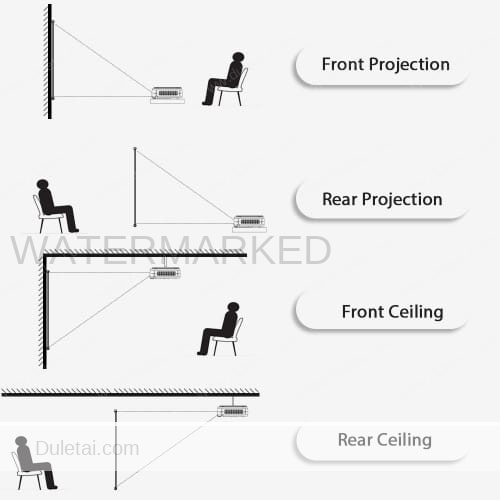
Front projection is when an image is projected on the front or viewers side of the projection surface. The image is then reflected back to the viewer. This is generally the classic style of projection that most people are familiar with, having seen it in schools and movie theaters. One of the biggest benefits for front projection, particularly on stage, is that it efficiently uses space, with no space required behind the screen. Usually, for front projection, the projector is placed above either the audience or the stage to avoid shadows of people and objects in front of the screen, but many times the shadows are unavoidable. Front projection screens are typically lighter in color since they need to reflect light, darker colors are possible which allow for deeper blacks and more saturated images but usually need a more powerful projector.
REAR PROJECTION:
Rear projection is when the projector is projecting onto the rear of the screen with the image going through the screen toward the viewer on the front side of the screen. Sometimes called RP screens, these screens can have wildly different characteristics since the screen controls how the image is transmitted. Some screens have tight viewing cones, with bright and crisp images while others have a softer image with wider viewing cone. This technique is often used in situations where objects or people in front of the screen would cause shadows if front projection was used, or when there is high ambient light since RP screens natural colors tend to be darker and fade into the background when not in use. The one draw back is that ample space is required for the projector to be positioned behind the screen. Usually taking up a significant amount of space that cannot be used for anything else.
SCREEN PERFORATION:
Perforation or microperforation is typically used to help alleviate acoustic pressure through a projection screen, particularly middle to high range frequencies. Standard perforation is 57,000 holes/m² (37 holes/in²) with an open area of approximately 7%; microperforation is 300,000 holes/m² (195 holes/in²) with an open area of approximately 6%.
CONTRAST:
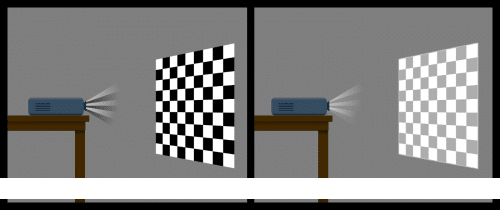
Contrast is simply the ratio between black and white. Picture contrast is considered good when black areas are perceived as highly distinct from white areas. To determine the contrast ratio of a projection screen, we use a checkerboard grid of eight black and eight white squares and an NIT meter that calculates the average values of the black and white squares. For projection under normal conference room conditions, the following is a contrast guideline: a ratio from 6:1 to 10:1 is considered bad; 20:1 and up is considered good.
MATERIAL WIDTH:
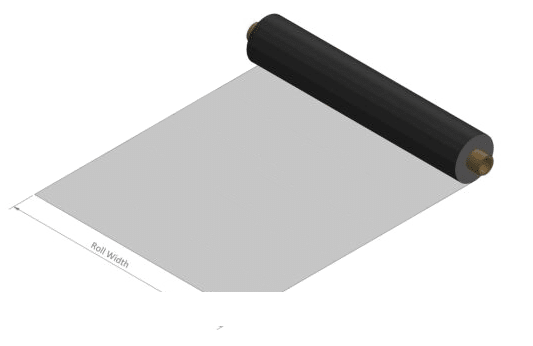
Screen manufacturer usually use material roll width as height. So most indoor applications, 3.2m width is enough. And some commerial theatre require a seamless super large screen, then a large width roll is needed. Material width is a feature decided by the projection screen material manufacturer’s machine and technology. For screen fabric which is made by multiple layer lamination technology, Duletai has 5.1m seamless capability. And for screen film thanks to the advanced calender machine imported from Italy, we have 4.8meters width capability while still maintaining a outstanding film flatness.
PROJECTION SCREEN FABRICS:
Projection screen fabrics usually formed by 3 layers: embossed front pvc layer+base fabric(Polyester or Fiberglass)+backside pvc layer. Some versions has surface coating to improve image contrast. This material does not require external tensions to create a flat surface. Projector screen fabric is widly used for all types of screens.
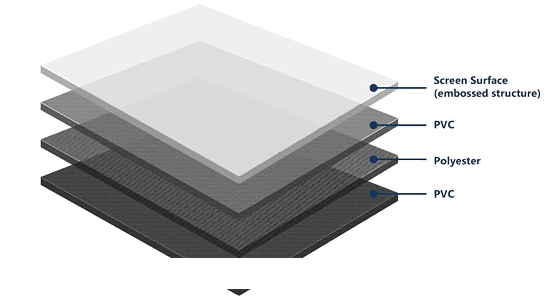
| Brand | Item NO. | Item Name | Wdith | Feature |
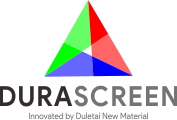 |
DLT-2001 | 4K PET | 2.20-3.20m | Flat, High resolution |
| DLT-2006 | White 300D woven | 2.20-3.20m | Flat | |
| DLT-2006K | Metal 300D woven | 2.20-3.20m | Hign Gain High Contrast | |
| DLT-2007 | Grey 300D woven | 2.20-3.20m | Flat, High Contrast | |
| DLT-2009 | White fiberglass | 2.20-3.20m | Flat, No curling, FR | |
| DLT-2009G | Grey fiberglass | 2.20-3.20m | Flat, No curling, FR, High Contrast | |
| DLT-2009K | Metal fiberglass | 2.20-3.20m | Flat, No curling, FR, High gain | |
| DLT-2012 | White warp knitted | 2.20-3.20m | Economical, Wide viewing angle | |
| DLT-2013 | Grey warp knitted | 2.20-3.20m | Economical, High contrast | |
| DLT-2019 | 5m seamless | 5.10m | Flat, Super wide | |
| DLT-2020 | Green screen | 1.50-2.10m | PVC free, Chroma Key | |
| DLT-2021 | ALR screen | 2.20-2.50m | Ambient light rejecting | |
| DLT-2026 | PU coated white black | 2.20-3.20m | Flat, No curling, PVC free | |
| DLT-2026G | PU coated grey black | 2.20-3.20m | Flat, No curling, PVC free |
PROJECTION SCREEN FILMS:
Projection screen film usually is single layer and the black back versions have 2 layers: embossed front pvc layer+black backside pvc layer. Some versions has surface coating to improve image contrast. This material is flexible so it requires external tensions to create a flat surface. Projector screen fabric is widly used for curved screens and tap tension home theatre screens.
| Brand | Item NO. | Item Name | Wdith | Feature |
 |
DLT-2002 | Grey black backed | 2.20m-4.80m | Double layer, High contrast |
| DLT-2003 | White black backed | 2.20m-4.80m | Double layer, Wide viewing angle | |
| DLT-2004 | Grey rear projection | 2.20m-3.66m | Translucent, Back throw | |
| DLT-2005 | 3D silver metallic | 2.20m-3.20m | High gain, High contrast, Metalic coating | |
| DLT-2018 | White single layer | 2.20m-4.80m | Light weight, Wide viewing angle | |
| DLT-2022 | Silver metal | 2.20m-3.20m | High gain, High contrast, Metalic coating | |
| DLT-2023 | Dark Silver perforated | 2.20m-3.20m | Acoustic transparency, High gain | |
| DLT-2024 | Dark Silver | 2.20m- 3.20m | ALR, High contrast |
Click image below to view product list of each catagory:
